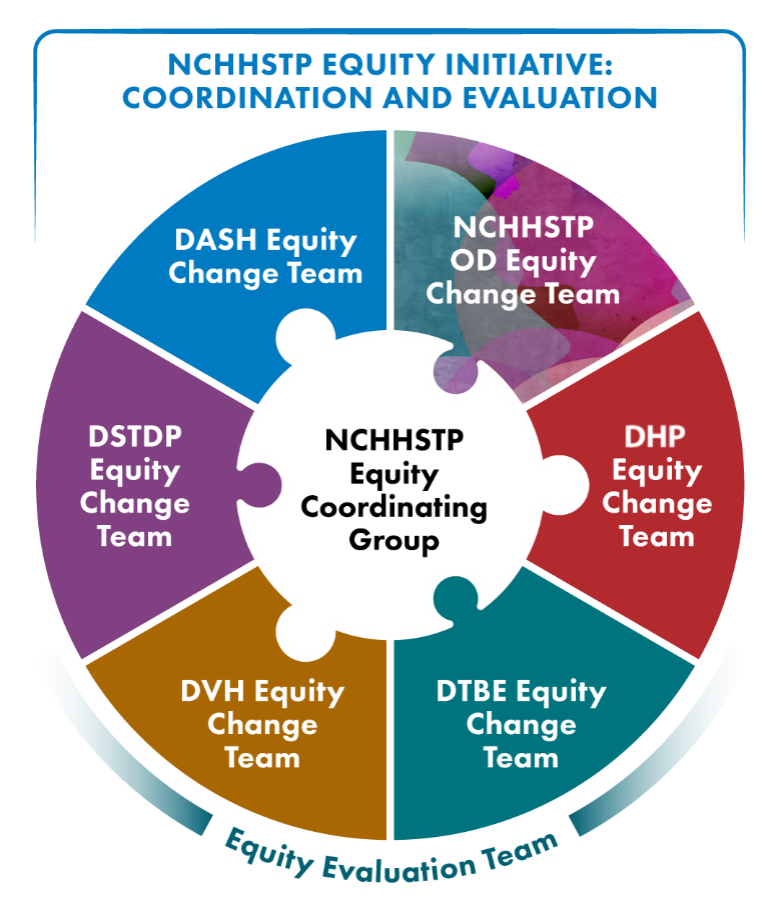Developing the NCHHSTP Equity Initiative and Implementation Plan
The Impetus
In spring 2019, the NCHHSTP Office of Health Equity and the Health Equity Workgroup began a formal process to create a shared understanding and long-term strategy for advancing equity across the Center. As a part of this process, NCHHSTP leaders conducted site visits and consulted with state and local health departments (e.g., New York City and Chicago) that had implemented their own equity initiatives. After two years of research and planning by a team of representatives from all five Divisions and the Office of the Director (OD) working closely with an organizational change consultant, the Center launched the NCHHSTP Equity Initiative.

Leading with Racial Equity
The NCHHSTP Equity Initiative Implementation Plan has an initial emphasis on racial equity, and includes objectives aimed at identifying and implementing strategies to eliminate racial disparities in health. The Equity Initiative leads with racial equity because of the stark racial disparities associated with HIV, viral hepatitis, STDs, TB, and adolescent health, and because racial and ethnic inequitiesi pervade the social determinants of health, including housing, education, employment, environmental exposures, and exposure to the criminal justice system.1 Racism is both a key determinant of population health and a root cause of racial health inequities.1,2 Thus, as experts have noted, “a focus on structural racism is essential to advance health equity and improve population health.”1
While the NCHHSTP Equity Initiative leads with race, it also addresses disparities and discrimination related to, but not limited to, gender, sexual identity and orientation, income, geography, and disability status—all factors that deeply influence the incidence, morbidity, and mortality associated with infections under the purview of NCHHSTP.
In summary, the NCHHSTP Equity Initiative engages all segments and levels of the NCHHSTP workforce to support NCHHSTP’s mission: “Save lives, protect people, and reduce health disparities associated with HIV, viral hepatitis, STDs, and TB.”
Operationalizing the NCHHSTP Equity Initiative
NCHHSTP is made up of the Office of the Director (OD) and five divisions: the Division of HIV Prevention (DHP), the Division of Viral Hepatitis (DVH), the Division of STD Prevention (DSTDP), the Division of TB Elimination (DTBE), and the Division of Adolescent and School Health (DASH).
The Implementation Plan established three key structures to achieve the goals and objectives of the Initiative: An Equity Coordinating Group; six Equity Change Teams; and an Equity Evaluation Team The Equity Coordinating Group, composed of diverse (e.g., by job type, position level, and demographic characteristics) representatives from the Center, provides consultation and support to the Equity Change Teams and coordinates cross-Center equity activities. The Equity Change Teams are charged with utilizing the goals and objectives of the Initiative to plan and coordinate equity activities within their organizational units. Finally, the purpose of the Evaluation Team is to develop a monitoring and evaluation plan, including indicators and measures and a detailed overall logic model, to monitor progress, effectiveness, and the impact of the Initiative. The Center will use results from the monitoring and evaluation process to determine whether and which new, expanded, or modified activities are needed to accelerate progress toward achieving the Initiative’s goals.
- Although race and ethnicity are distinctly different social constructs, they are intertwined. “Racial diversity occurs within ethnically defined groups; ethnic diversity occurs within racial and ethnic groups; moreover, social forces differentially affect groups based on the interactions of race and ethnicity.” 3 In addition, “racialization fundamentally influences the social and public health implications of ethnicity.” 3 Therefore, in the context of this document, the terms “racial disparities” and “race-based disparities” are intended to include ethnic disparities.
- Bailey ZD, Krieger N, Agénor M, Graves J, Linos N, Bassett MT. Structural racism and health inequities in the USA: evidence and interventions. The Lancet. 2017;389(10077): 1453 -1463.
- Ford CL, Griffith DM, Bruce MA, Gilbert KL, eds. Racism: Science & tools for the public health professional. Washington DC: APHA Press; 2019
- Ford CL, Harawa NT. A new conceptualization of ethnicity for social epidemiologic and health equity research. Soc Sci & Med. 2010;71(2): 251-258.


